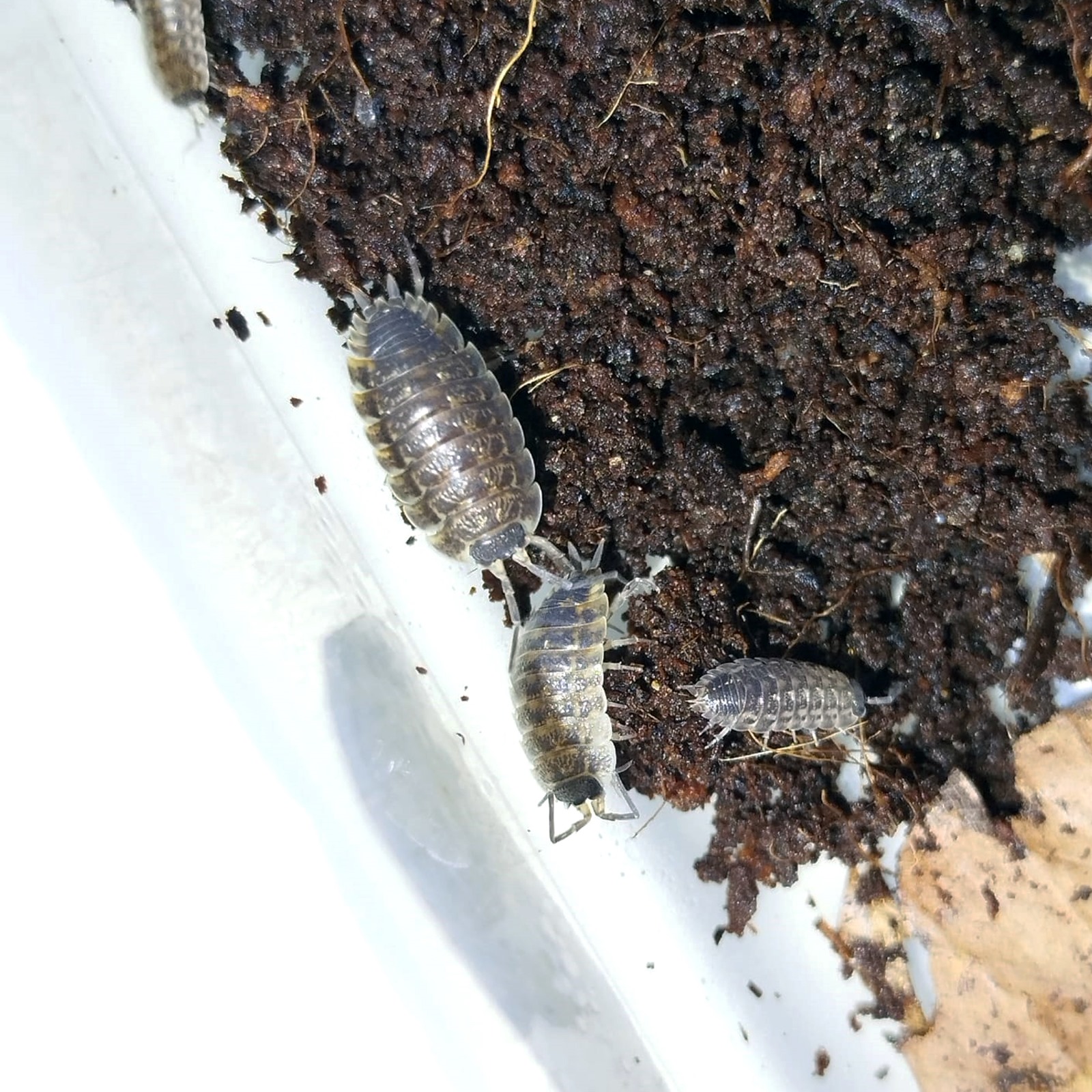
Armadillidium granulatum
0,50€ – 4,00€Price range: 0,50€ through 4,00€

Armadillidium peraccae
1,40€ – 12,00€Price range: 1,40€ through 12,00€
Porcellio spinicornis
0,50€ – 4,00€Price range: 0,50€ through 4,00€
Introduce Porcellio spinicornis into your bioactive terrarium. This terrestrial isopod is an effective natural recycler, ideal for breaking down organic matter and improving the quality of the substrate. Hardy and adaptable, it is key to maintaining a healthy and balanced environment.
SKU:
N/A
Categories: Arthropods, Isopods, Porcellio
Description
Technical sheet of the isopod: Porcellio spinicornis
Scientific Name: Porcellio spinicornis
Taxonomic Classification:
- Kingdom: Animalia
- Phylum: Arthropoda
- Class: Malacostraca
- Order: Isopoda
- Family: Porcellionidae
- Genus: Porcellio
- Species: Porcellio spinicornis
Common Name: Terrestrial isopod, woodlouse, pill bug (although it doesn’t fully roll up).
General Description:
- Size: Between 10 and 15 mm in length.
- Color: Typically dark gray or brown in color, with possible greenish or yellowish hues.
- Body: The body is dorsoventrally flattened, composed of rigid, articulated segments, providing some flexibility.
- Antennae: Possesses two pairs of antennae. The second pair is long and oriented forward, while the first pair is much shorter.
- Particularity: The name spinicornis refers to the spiny projections found at the tips of its antennae.
Habitat:
- Distribution: Mainly distributed throughout Europe but has been introduced to other parts of the world.
- Environment: Inhabits humid areas such as forest floors, under rocks, logs, and leaf litter. It can colonize urban areas, living in gardens, basements, and other moist zones.
Feeding:
- Diet: Detritivore, feeding on decaying organic matter such as dead leaves, rotting wood, and other plant debris.
- Ecological Importance: Plays a crucial role in nutrient cycling by breaking down organic material in ecosystems.
Behavior:
- Activity: Primarily nocturnal, as it seeks shelter in dark, damp places during the day to avoid desiccation.
- Social Behavior: Lives in small colonies under suitable conditions. Prefers high-humidity areas to maintain body hydration.
Reproduction:
- Life Cycle: Females carry the eggs in a ventral chamber called a marsupium, where the embryos develop until hatching.
- Lifespan: Can live between 1 and 2 years, depending on environmental conditions.
Adaptations:
- Respiration: Has pseudotracheae on its abdominal surface that allow it to breathe, but it requires humid environments to keep these structures functional.
- Defenses: Though it doesn’t roll up entirely like some woodlice, it can hide in small crevices to avoid predators.
Additional information
| Options |
1 unit ,10 units |
|---|
Related products
Creobroter gemmatus
10,00€ – 25,00€Price range: 10,00€ through 25,00€
Sold out
Descobreix el fascinant món de la Jewel Mantis: una criatura exòtica i enigmàtica que et convida a explorar el seu comportament únic. Submergeix-te en l'estudi del seu camuflatge, la seva agilitat en la caça i la seva bellesa captivadora. Una experiència que desperta la curiositat i et connecta amb la natura d'una manera inspiradora!
Select options
This product has multiple variants. The options may be chosen on the product page
Grammostola porteri (Rosea)
22,00€
there is stock
Discover the fascinating company of the Grammostola porteri tarantula! With its unique beauty and adaptability to different terrariums, this tarantula is perfect for beginners in the world of exotic pets. Dare to explore the magic of nature in your home with this captivating tarantula. 🕷️
Select options
This product has multiple variants. The options may be chosen on the product page
Brachypelma hamorii (ex smithi)
12,00€ – 90,00€Price range: 12,00€ through 90,00€
there is stock
Transform your terrarium into a vibrant haven with this unique tarantula. Ideal for beginners in tarantula breeding! Discover the fascinating world of these arachnids, an unforgettable learning experience!
Select options
This product has multiple variants. The options may be chosen on the product page
Cubaris jupiter
there is stock
Cubaris panda king
1,20€ – 5,00€Price range: 1,20€ through 5,00€
there is stock
Discover the fascinating life in miniature with the Cubaris Panda King: small guardians of ecological balance for your terrarium. Bring your habitat to life with these adorable and beneficial companions!
Select options
This product has multiple variants. The options may be chosen on the product page
5,00€
there is stock
Discover the vibrant world of miniature nature with our Porcellio laevis Orange! These charming orange isopods will add a unique splash of color to your terrarium. Easy to care for and fascinating to observe, get yours today and bring your environment to life!
Select options
This product has multiple variants. The options may be chosen on the product page
Pseudoglomeris Magnifica
8,00€ – 60,00€Price range: 8,00€ through 60,00€
Sold out
Discover the stunning Emerald Cockroach (Pseudoglomeris Magnifica), its vibrant green color and unique presence make it a fascinating addition to any environment! Get yours now!
Select options
This product has multiple variants. The options may be chosen on the product page
Peruphasma schultei
15,00€ – 22,50€Price range: 15,00€ through 22,50€
Sold out
Select options
This product has multiple variants. The options may be chosen on the product page
























